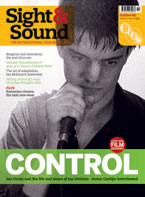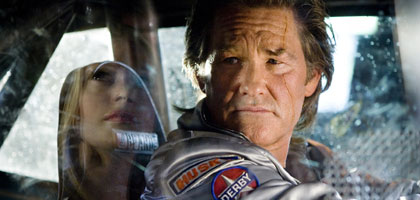
Death Proof
USA 2007

Reviewed by Tony Rayns
Synopsis
Our synopses give away the plot in full, including surprise twists.
Austin, Texas. Maverick DJ Jungle Julia has a boozy reunion with her old college friends Shanna and Arlene; she has teased listeners by promising that Arlene will lap-dance for anyone out on the town who recognises her by her butterfly tattoo. After eating at Guero's they move on to the Texas Chili Parlor (proprietor: Warren), where they effortlessly fend off admirers Dov, Nate and Omar. A strong, silent man at the bar who calls himself Stuntman Mike has been watching them and steps up to claim the lap-dance from Arlene. Seemingly gallant, Mike offers to drive the stranded customer Pam home in his Dodge Charger, a vehicle customised for movie stunt work which has no passenger seat. After driving in a way that deliberately kills Pam, he seeks out Jungle Julia's Honda Civic and rams it head-on at high speed, dismembering Julia and her friends.
Tennessee, 14 months later. Stuntwomen Kim and Abernathy encounter Stuntman Mike outside a convenience store while en route to the airport to pick up their Kiwi friend Zoë Bell, arriving to work with them on the film Cheer Up in Texas. Zoë wants nothing more than to drive a 1970s Dodge Challenger (as seen in Vanishing Point) and has found one for sale on the internet; the girls head out to Jasper's farm to inspect it and trick Jasper in letting them test drive it, leaving their actress friend Lee behind as collateral. On the country roads, Zoë tries the "ship's mast" stunt, riding on the roof of the car while holding on to leather straps. But Stuntman Mike is watching and begins chasing them in his Dodge Charger, trying to knock Zoë off the car and force it to crash. After a long chase Mike crashes and is finished off outside his car by the girls.
Review
Shorn of its Grindhouse co-feature Planet Terror, and of the four trailers for non-existent movies which completed the original package, Death Proof has nonetheless put on weight: as a solo act, it runs for a gruelling 114 minutes as against the 87-minute original. Still present are the artfully distressed leaders announcing "Our Feature Presentation" and the "Restricted" rating, along with other fetishistic marks of the vintage grindhouse experience, such as occasional deep scratches, smears and dodgy colour processing (at one point it lapses into monochrome). All of which is bizarre and anomalous, since Death Proof in no way resembles the kind of genre movie that used to be projected until it fell to pieces in the fleapits of America. The conceptual logic is all screwed up. Even the one movie to which Tarantino pays protracted homage - Richard C. Sarafian's Vanishing Point (1971) - wasn't an authentic grindhouse product; it was produced by a British company and distributed to mainstream theatres in the US by 20th Century-Fox.
Maybe this shouldn't be a surprise. Tarantino put the Shaw Brothers' logo on the front of Kill Bill, but neither part of that film was anything like a Shaw production, even with the sublime Gordon Liu in the cast. Butif Death Proof isn't a proper grindhouse movie, what is it? First and foremost, it's a game of two halves - sort of like an Apichatpong Weerasethakul film, but less so. In the first half, several raunchy, foul-mouthed young women get drunk, tease and humiliate assorted men - and then pay the price for being uppity by getting mown down in their prime by a psychotic loner who gets his kicks from dismembering women in car crashes. (As played by Kurt Russell, much like a refugee from some Coen Brothers farrago, the psycho Stuntman Mike doesn't seem much of a bookworm. But he's clearly an avid interpreter of J.G. Ballard.) In the second half, several equally raunchy and foul-mouthed young women (more Hawksian than the last lot, to be film-nerdy about it) get high on joy-riding an old Dodge Challenger, only to be attacked by the same psychotic loner. Spoiler alert: this lot get the better of him and kill him.
The overgrown boys at whom the film is targeted will immediately recognise this structure as one from the world of the Playstation: it's like repeating one level of a game and reaching a different outcome. This represents another departure from the grindhouse tradition (schlock genre movies pretty much always followed the three-act rules of melodrama) but not necessarily an aesthetic advance. Since there's no plot to speak of and next to no dramatic traction between the two halves, Tarantino fills the first with his trademark banter and the second with an intermittently exciting but extremely protracted car chase. A fawning review in Variety compares Tarantino with Joseph L. Mankiewicz ("so easily does he create reams of dialogue in distinct voices and so well does he direct it"), but in truth the "trash talk" this time has much less brio and is far less memorable than the verbal rallies in Reservoir Dogs and Pulp Fiction. Stuntman Mike's slyly misogynistic aphorism "Few things are as fetching as a bruised ego on a beautiful angel" is as good as it gets.
Time was, Tarantino looked like a new broom, returning American cinema to its pop-culture roots and revitalising it for faster and more demanding times. Now he seems more like the cinematic equivalent of a crack addict, constantly trying to cap the last high, inexorably losing discrimination in the mix'n'matching of his sources. In this light, the repeat casting of Michael Parks as Earl McGraw (from Kill Bill, etc) looks more like a symptom than a cute self-reference. The best impulse here was to pull Zoë Bell out of anonymity (she was Uma Thurman's stand-in on Kill Bill) and give her a 'starring' role in her own right. The worst was Tarantino's inability to resist giving himself a meaningless cameo as a barman. Meanwhile the overgrown boys are clearly losing interest (the Grindhouse package nosedived at the US box-office) and so the question arises: who is all this for?
Credits
- Directed by
- Quentin Tarantino
- Produced by
- Elizabeth Avell¡n
- Robert Rodriguez
- Erica Steinberg
- Quentin Tarantino
- Written by
- Quentin Tarantino
- Director of Photography
- Quentin Tarantino
- Edited by
- Sally Menke
- Production Designer
- Steve Joyner
